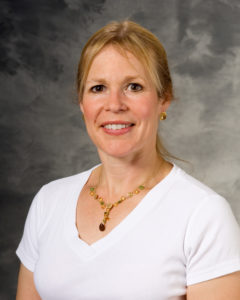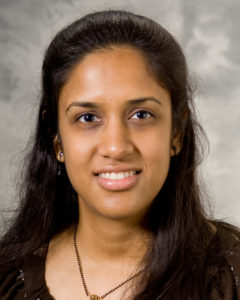Nov. 2, 2016:
Investigator Spotlight
Natalie Callander, MD, is a hematologist at the University of Wisconsin Carbone Cancer Center who focuses on the treatment of patients with multiple myeloma, the second most common form of blood cancer. She serves as co-chair of the Big Ten CRC’s Multiple Myeloma Clinical Trial group, along with Dr. Craig Cole of the University of Michigan. “Our mission at the Big Ten CRC is to foster collaboration between researchers and industry partners in order to develop novel therapies, particularly for patients with relapsed myeloma,” Callander said. “We also hope to provide young investigators a venue to explore new treatment paradigms.”
of blood cancer. She serves as co-chair of the Big Ten CRC’s Multiple Myeloma Clinical Trial group, along with Dr. Craig Cole of the University of Michigan. “Our mission at the Big Ten CRC is to foster collaboration between researchers and industry partners in order to develop novel therapies, particularly for patients with relapsed myeloma,” Callander said. “We also hope to provide young investigators a venue to explore new treatment paradigms.”
Callander is the Medical Director of the Myeloma Clinical Program at UW, where she has worked to increase the number of high quality myeloma clinical trials. Under her leadership, UW has become the one of the top accuers for myeloma clinical trials in ECOG (the Eastern Cooperative Oncology Group). She also assembled a myeloma translational research group on campus, including Shigeki Miyamoto, PhD, Peiman Hematti, MD, Fotis Asimakopoulos, MB, PhD, and Alan Rapraeger, PhD, which has been working together now for nearly a decade. One of her projects involves collecting bone marrow samples from myeloma, patients, so that their tumor cells can be studies in a variety of ways. One investigation involves the study of how drug resistance develops and to identify new biological markers that could serve as therapeutic targets. Their group is also researching a personalized approach to treatment, where they test drug therapies on both cancerous and healthy cells culled from these donated bone marrow samples to accurately recapitulate the marrow microenvironment. “We hope that this approach will lead to a real time method of helping to decide the best treatments for relapsed patients, and ultimately spare them from ineffective and potentially toxic drugs,” Callander said.
This past September, Callander was selected to serve as Vice Chair of the National Comprehensive Cancer Network’s (NCCN) multiple myeloma panel. The NCCN panel evaluates myeloma treatments, taking into account both efficacy, data quality and cost. Callander noted that multiple myeloma has become one of the costliest diseases to treat, mainly due to two positive factors: the number of available treatments has increased significantly over the past 20 years, and patients are living longer. The panel’s recommendations are used by oncologists, insurance companies and the federal government to inform the national standards of care for this disease. She is also a member of the Clinical Trials Network, ECOG and the NCI Myeloma Steering Committee.
Callander additionally attends on the bone marrow transplant and hematology services, and sees outpatients at both the Carbone Cancer Center and the William S. Milddleton Veterans Medical Center.
Thought Leader Perspectives
 Vaishalee Kenkre, M.D., assistant professor of medicine within the division of hematology/oncology at the UW School of Medicine and Public Health and at the William S. Middleton Memorial Veterans Hospital.
Vaishalee Kenkre, M.D., assistant professor of medicine within the division of hematology/oncology at the UW School of Medicine and Public Health and at the William S. Middleton Memorial Veterans Hospital.
This article is used by permission. See the original post at OncLive.com
There are few efficacious treatment options for patients with Hodgkin lymphoma and aggressive non-Hodgkin lymphoma who have previously failed autologous stem cell transplant (ASCT) or who are ineligible for ASCT due to progressive disease. There are also limited options for patients with indolent lymphomas who have suffered multiple relapses. In both of these patient populations, there is a need for novel and ideally curative options.
Allogeneic hematopoietic cell transplantation has been studied in lymphoma, both in aggressive histologies1-9 and indolent histologies.10-14 Studies support a potential for graft-versus-lymphoma (GVL) effect, though often at the cost of significant treatment-related morbidity and mortality. Complications often arise as a result of graft-versus-host disease (GVHD).
While rates of acute GVHD with reduced-intensity conditioning regimens may range relatively lower (10% to 20%), rates of extensive chronic GVHD range from 45% to 60%, even with human leukocyte antigen (HLA) matched donors.13, 14
Additionally, standard practice involves identifying a sibling who is an HLA-match, and if not available, searching for an unrelated donor, which can delay or even negate the possibility of transplant for such patients. The optimal scenario would be one in which GVL could be optimized while minimizing GVHD, and donors could be identified quickly.
Our pilot trial, to our knowledge, is the first of its type to investigate T cell receptor alpha/beta (TCRa/β)-depleted and CD19-depleted haploidentical stem cell grafts in relapsed/refractory lymphoma patients. We hypothesize that TCRa/β and CD19 depletion from haploidentical stem cell grafts in patients with relapsed/refractory lymphoma will lead to successful engraftment along with lower rates of acute and chronic GVHD than typically seen after matched donor transplantation in lymphoma patients, and ultimately a long lasting GVL effect.
TCRa/β cells and B cells are thought to be major players in mediation of GVHD. Selective removal of these cells from the transplanted graft would minimize GVHD, while still allowing for a meaningful GVL effect (from TCRγ/δ cells and other important mediating cell types).
First clinical experiences in TCRa/β-depleted and CD19-depleted PBSC grafts have been obtained in haploidentical transplantation with pediatric patients in Tübingen.15,16 All patients were at extremely high risk and had poor prognosis. They were pretreated with a reduced-intensity conditioning (RIC) regimen and received no post-transplantation immunosuppression. In these pilot patients, engraftment and immune reconstitution were rapid. No acute side-effects were noted. Similar small studies, primarily in pediatrics and conducted in Europe, have replicated similar data.
There is growing evidence that haploidentical donor transplants (primarily using post-transplant cyclophosphamide as immunosuppression) may be just as efficacious, if not more so, than matched unrelated donor transplants for adult patients with lymphoma.17
Furthermore, in aggressive lymphomas, even data with matched related donor transplants is not highly promising,18-20 and the use of haploidentical donors is even more compelling and potentially associated with better disease control and less GVHD.21
Additionally, haploidentical donors are typically readily available. In theory, virtually every patient has a potentially suitable haploidentical related donor—parent, sibling, or child—and thus a successful strategy for haploidentical donor transplantation may clearly be the solution for the ‘lacking donor’ problem.
Although preliminary data with TCRa/β – and CD19-depleted haploidentical graft transplantation is promising, any data with this type of graft manipulation in patients with lymphoma, while highly warranted, is lacking.
We have developed a novel clinical protocol including a new conditioning regimen. Our clinical cell processing laboratory at University of Wisconsin Hospital and Clinics has validated the depletion strategy being used for this study and is one of the first in the country capable of providing this for clinical use.
Our trial is open to patients with relapsed/refractory Hodgkin lymphoma, diffuse large B cell lymphoma, follicular lymphoma, small lymphocytic lymphoma/chronic lymphocytic leukemia, mantle cell lymphoma, and T cell lymphoma. They will receive fludarabine/cyclophosphamide/ total nodal irradiation conditioning followed by transplantation of a haploidentical stem cell product that has undergone TCRa/β – and CD19-depletion. Although the primary endpoint for the study is engraftment of neutrophils and platelets by day 28, the incidence of acute and chronic GVHD and progression-free survival and overall survival are all included as secondary endpoints. Additionally, patients will have a detailed and highly sophisticated immunophentypic analysis by flow cytometry of peripheral blood lymphocytic populations at various time points after transplant to look for correlation to disease response, graft versus host disease, infection rates, and other potential side effects.
About the Big Ten Cancer Research Consortium: The Big Ten Cancer Research Consortium was created in 2013 to transform the conduct of cancer research through collaborative, hypothesis-driven, highly translational oncology trials that leverage the scientific and clinical expertise of Big Ten universities. The goal of the Big Ten Cancer Research Consortium is to create a unique team-research culture to drive science rapidly from ideas to new approaches to cancer treatment. Within this innovative environment, today’s research leaders collaborate with and mentor the research leaders of tomorrow with the unified goal of improving the lives of all patients with cancer.
About the Big Ten Conference: The Big Ten Conference is an association of world-class universities whose member institutions share a common mission of research, graduate, professional and undergraduate teaching and public service. Founded in 1896, the Big Ten has sustained a comprehensive set of shared practices and policies that enforce the priority of academics in the lives of students competing in intercollegiate athletics and emphasize the values of integrity, fairness and competitiveness. The broad-based programs of the 14 Big Ten institutions will provide over $200 million in direct financial support to almost 9,500 students for more than 11,000 participation opportunities on 350 teams in 42 different sports. The Big Ten sponsors 28 official conference sports, 14 for men and 14 for women, including the addition of men’s ice hockey and men’s and women’s lacrosse since 2013. For more information, visit www.bigten.org.














Subscribe to the Big Ten CRC Newsletter X
X Facebook
Facebook YouTube
YouTube